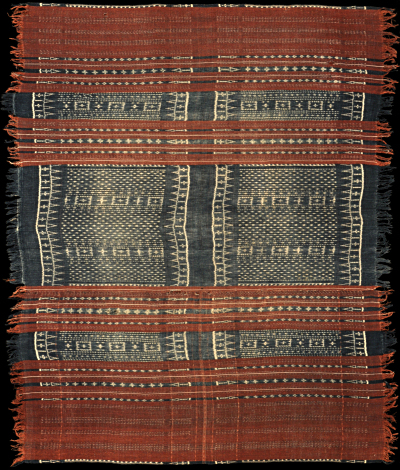| |
 
 | | | |
052 Flores Group, Nage Keo
Hoba (sarong)  
| | Locale: | Village unknown. | | Period: | 19th to early 20th c. | | Yarn: | Cotton, hand-spun, fine | | Technique: | Warp ikat | | Panels: | 3 | | Size: | 152 x 201 cm (4' 11" x 6' 7") LW: 1.32 | | Weight: | 820 g (28.9 oz), 268 g/m2 (0.88 oz/ft2) | | Design: | Hoba pojo, skirt, of the type with red end panels called singi to. Three panels sewn together. Wide bands with small geometrical patterns in white on indigo, separated by narrower bands in rust brown. Lateral borders with tiny tumpal motifs. | | Comment: | Well worn piece, with a few small tears on seams not affecting overall pattern. Colours slightly faded but still expressive. Hamilton: 'Even the best old [Nage Keo] cloths in museums are coarsely woven.' This one is no exception: weaving is fairly loose, but of very good overall quality. The patterning is finely executed, above average for the region, revealing the hand of a master weaver. Remarkably, the narrow lateral borders, which on many older pieces are largely or entirely missing, are fully intact. From old Dutch collection. | | Background: | Chapters on Flores Group and Nage Keo. | | Exhibited: | Museu do Oriente, Lisbon, 2014/15 | | Published: | Woven Languages, 2014.Ikat Textiles of the Indonesian Archipelago, 2018.
| | Compare: | 108 197 | | Sources: | Nearly identical to hoba in Maxwell, ed., Textiles of Southeast Asia, Fig. 95. Also see Khan Majlis, Indonesische Textilien, Wege zu Goettern und Ahnen, Fig. 363, 364, 365. Similar to cloth in Nusantara Museum, No. S 2365-67. Also see Hamilton, ed., Gift of the Cotton Maiden, p. 113 and Fig. 5-23 (similar but singi pojo, with blue end panels); and Textile Museum of Canada, T84.0219, T84.0220, T84.0221. Another similar piece but decades younger in the collection of Museum für Völkerkunde, Vienna, is depicted in Leigh-Theisen and Mittersaksenschmöller, Lebensmuster, Abb. 141. Another much younger piece, otherwise nearly identical, in Yoshimoto, Ikat. | | |

©Peter ten Hoopen, 2025
All rights reserved.
|
|


